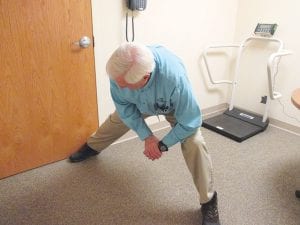Participants in mock shooter exercises practice the basic options available in a shooter situation. Above: This woman hides, but has a “weapon” handy—an aerosol can which could possibly be sprayed in an attacker’s face. Left: Participants were taught methods of barricading themselves so attackers would be discouraged and move on.

Gunshots rang out in the physical therapy department at Cook County North Shore Hospital in the early morning hours of February 29. Employees of the hospital and the Sawtooth Mountain Clinic took cover anywhere they could find as an armed intruder stalked the hallways. Thankfully, it was all part of a prearranged training session. But what if the horror had been genuine?
In the wake of many similar real incidents happening globally in recent months and years, the violence in the workplace committee comprised of hospital staff and a clinic representative, organized the exercise. Minnesota legislation enacted in 2015 requires hospitals to conduct a de-escalation training known as Management of Aggressive Behavior for staff to aid in mitigating these types of situations. The clinic chose to follow a comparable path and develop equivalent guidelines as well.
Mike Marturano, the safety officer of St Luke’s Hospital, conducted classroom instruction a few weeks prior to the live shooter session. A main point was to always be aware of your surroundings. Having a preconceived plan of where you can go and what you can do may be the difference between life and death.
Visualizing potential circumstances and practicing how you will react to them is also important. In an actual emergency be prepared for tunnel vision and the loss of basic motor skills. Dialing 9-1-1, using keys or codes on door keypads may become nearly impossible. Rehearsing ahead of time will give you some muscle memory to be able to perform under pressure.
Be prepared to shout warnings to others who may not be aware of the intruder. “Do not pull the fire alarm. All you’ve done is to invite someone with a garden hose to a gun fight,” said Marturano.
In a shooter situation there are three basic options—running, hiding or fighting. Take note of where exits are and how you will get to them. Many people enter and exit their work areas exactly the same way every day and are at a loss when that routine is broken. Be aware of alternative routes if your usual exit is unavailable. Keep in mind that if you are confronted with a shooter a moving target is much more difficult to hit and that even if hit, a gunshot wound will not necessarily kill you.
Shooters normally are looking for human targets with the sole goal of increasing the body count as rapidly as possible. Incidents of shots being fired through doors and walls are rare. A foot in a rubber soled shoe wedged against the bottom of a door can be enough to move the perpetrator away from your hiding place. Also practice moving furniture and fixtures to block doors so you know it can be done if it does ever become necessary.
“Everything in this room is a weapon, sir!” said Marturano quoting a young Marine who had attended a previous teaching session. Marturano added that if it comes down to a physical confrontation, “Be prepared for the fight of your life, for your life.”
Assess everything at your disposal as a weapon whether it is a pen, a clipboard, a spray can, or even using the attacker’s own weapon against him.
You might need to make immediate hard decisions. If someone is frozen in shock or for any reason unable to run, do you help them or flee? If you stay, will it help or are you now just an additional target? Do you barricade a door now or do you wait for others? What split second decisions you make, may determine if you arrive home alive.
Marturano with the assistance of Cook County Sheriff Pat Eliasen and Bailiff Gary Radloff conducted three mock attacks varying their entry points and details with each. In one exercise a hostage was taken and ordered at gunpoint to ask others locked in various offices to open the door to let her in. Appropriately, no one did.
In another scenario the gunman burst into the waiting room, with people sitting and checking in for their appointments. As they would not have been anticipating the violence there would have been unavoidable casualties. Marturano said that over the course of the three simulations there would have probably been three or four victims hit.
While these specific scenarios used a firearm, Marturano pointed out that the attacker’s weapon could be any number of things including a baseball bat or a machete. Recently similar situations involving knife attacks in schools have been increasing in China.
Most shooters are not professionally trained. Many plan that they will continue until they are killed themselves. About 47 percent of the intruders are eventually subdued by their potential victims.
Marturano, who is also available to conduct trainings for other organizations, stressed repeatedly that a real life situation is very little like the movies. Actual gunshots indoors tend to be muffled or even inaudible in other areas of the building. The participants agreed that the shots sounded more like a large book being dropped than what you would think a gunshot would sound like.
One participant summed up, “Even knowing it was just a drill, there’s a distinct feeling of terror hearing the pop-pop of a rifle outside the door as a shooter attempts to force his way in. Let’s hope it never happens. But be prepared if it does.”



Loading Comments